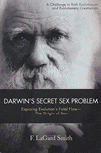Return to 4th Quarter 2018 articles.

In the Does God Exist? ministry we try to help people who have loved ones who have lost their faith or who question their own faith. It is crucial for us to know what questions people are asking. It is also vital that we not present wrong or superficial arguments for the existence of God. We try very hard not to be guilty of any of these things. The primary way we do that is by listening to atheists and skeptics and trying to understand their arguments. I personally subscribe to about twenty periodicals produced by atheist or skeptic organizations, and carefully look at letters and e-mails that oppose what we are teaching. Hate mail is easy to discard, but thoughtful, critical responses to our message are beneficial to us.
One such argument comes from those who suggest that we are making a “god of the gaps” argument. That would be where we take a subject and look at all the reasons why it could not have come into existence by chance and say that since it could not happen by chance, God must have done it. That is using God to cover our ignorance by filling the gap in our understanding.

The “god of the gaps” criticism is valid. There is quite a bit of apologetic material on the Web, in books, and in periodicals that falls into that trap. Historically humans have leaned heavily on “god of the gaps” ideas to invent gods. When ancient people did not understand how volcanoes worked, they invented a god or goddess of the volcano. To this day, some refer to Pelee as the goddess that causes volcanoes. Others believed that Minerva was the goddess of weather, and Thor, the god of lightning.
What happens in “god of the gaps” arguments is that when scientific explanations make it clear what caused the volcano, the weather, or lightning, the god that was invented to explain the phenomena is no longer needed. Atheists have said “God is dead” because our knowledge now explains everything that previously was attributed to God.
Any use of design arguments has the potential to fail when our “designs” turn out to be natural products of chance. There are a variety of ways that we can avoid falling into the “god of gaps” trap, and we would like to suggest a few of them.
1. “Occam's razor (or Ockham's razor) is a principle from philosophy. Suppose there exist two explanations for an occurrence. In this case, the simpler one is usually better. Another way of saying it is that the more assumptions you have to make, the more unlikely an explanation is” (Webster's Collegiate Dictionary).
Skeptics sometimes send me dissertations explaining how something that we have suggested is a product of design could have come into existence by chance. There are always massive numbers of assumptions involved in their explanations. A classic example of this can be found in a recent issue of a major scientific magazine:
In the beginning, there was nothing but cold and dark between the atoms that became the solar system. No sun existed 4.6 billion years ago, only a gossamer cloud of remains from earlier stars, stocked with elements forged in previous cataclysms beyond our comprehension. And then something happened. Maybe a passing celestial nomad's gravity nudged the cloud, or maybe a more distant star exploded, loosing a wind that ruffled the atoms, just as a breeze can push leaves into a pile.
— Scientific American, June 2018
Suggestions like this are not a report of history, but they could be proposals that can lead to scientific investigations. At the very best, they are a guess as to how God may have molded what he had already created into what we see today. This leads us to the second reason that our arguments are not just “god of the gaps” arguments.
2. Statistical analysis eliminates “god of the gaps” claims. The fact that you can propose a model of how something could have happened does not mean that your model is in fact what took place. The next step in arguing that God is the creator is to ask what is statistically reasonable. The definition of Occam's Razor points out that “the more assumptions you have to make, the  more unlikely the explanation is.” In the famous case of Darwin's finches, there were only one or two assumptions involved, but evolutionary explanations of specializations in living things always involve massive numbers of assumptions. As F. LaGard Smith pointed out in his book Darwin's Secret Sex Problem (reviewed in our 3rd quarter 2018 issue), to explain a major leap in evolutionary change from asexual to sexual reproduction the number of assumptions involved would be huge.
more unlikely the explanation is.” In the famous case of Darwin's finches, there were only one or two assumptions involved, but evolutionary explanations of specializations in living things always involve massive numbers of assumptions. As F. LaGard Smith pointed out in his book Darwin's Secret Sex Problem (reviewed in our 3rd quarter 2018 issue), to explain a major leap in evolutionary change from asexual to sexual reproduction the number of assumptions involved would be huge.
What is an acceptable probability? On a common sense level, it is not very high. Jumping out of an airplane with no parachute of any kind is the example we have used in our presentations. An American Parachute Club member at one time gave the odds as one in ten million for jumping out of a plane at 10,000 feet and surviving. If I offered you a million dollars to do that, would you feel the odds are good enough?

The classic response to this suggestion is to say that in the matters we are discussing the element of time makes the parachute analogy meaningless. The usual response is,“If you have infinite time then anything can happen.” That is debatable, but more to the point is that we don't have infinite time for anything that involves the physical cosmos. If you are talking about the odds of an animal having a specific characteristic you only have the length of time that the species existed. If you are talking about a feature of humans, you only have the length of time that humans have existed.
Apologists have quoted biologists and Nobel Prize winners as giving odds of one chance in 10 to the 160th power for events leading to the formation of life. That translates into 10 to the 243rd power years, and no scientist suggests that the universe is that old. Accepting odds that are in this range of magnitude to avoid the simple concept that intelligence guided the processes is unreasonable. Yet we see today an indication of pure bias against what is a reasonable alternative to chance.

3. Having two choices as the answer to a cause is not a “god of the gaps” argument. Many arguments for the existence of God take a phenomenon and provide a base which says that there are two possible explanations. Either it was a product of mechanical processes which now or in the future, we will be able to explain by naturalistic processes, or it is the product of an intelligence that designed and/or directed the process. When we look at how sexual reproduction came into existence, either it is a natural evolutionary process that we can understand now or in the future, or an intelligence designed it.
The problem with the naturalistic explanation is that there are multiple parts which all must work and work together to allow reproduction to occur. In human reproduction, for example, you have to explain the evolutionary development of each part of the male and female organs that enable sexual reproduction to occur. If any one of them is not there, is not functioning well, or is not timed correctly, sexual reproduction will not happen. Not only do the mechanical parts have to work together at the right time, but also the chemical agents and brain components that motivate bringing the egg and the sperm together. That is only after each of them has evolved to the point of being fertile.
As science examines the evidence, the complexity of the reproductive system has made it more and more difficult to fit into any evolutionary scenario, but that choice is one option. The other alternative is that all of this has been planned and intelligently designed. That would mean it has been designed not only to make the fertilization and implantation happen, but to give the joy, pleasure, and bond that sexual reproduction uniquely brings to humans. This is not an invention of a god to fill in gaps of understanding, but a choice as to what the evidence best supports.

4. Multidisciplinary evidence denies “god of the gaps” challenges. Many arguments for the existence of God have multiple lines of evidence to support the claim that God is the creator. As an example of this, we can examine the evidence that humans are not just animals driven by evolutionary forces in the environment. The evidence from anatomy shows that the human brain is not exceptional in size, organization, or function even though our ability to think and reason far exceeds that of any animal. The evidence from environmental science shows that modification of the environment is unique to humans. The evidence from philosophy shows that humans are often willing to die for something that does not promote their existence or the existence of their progeny. That is a uniquely human trait. The evidence from psychology shows many human actions that have no survival value such as creating art, practicing religion, feeling guilt or sympathy, or being able to be taught to think. Political science offers perspectives on human behavior that are unique to us and how we organize our society.
In many of those areas of study, there is great debate among researchers as to how these characteristics developed and why. Once again, the assumptions involved are enormous, but because the evidence comes from many disciplines, no singular cause can be ascribed to these characteristics.
5. Religious experience denies “god of the gaps” challenges. By “religious experience” we are referring to where our conclusion about the existence of God takes us. We can consider humans a special creation of God uniquely created in his image, or as animals entirely produced by chance processes and our environment. What difference does it make? It makes a world of difference. We express our spiritual makeup in a huge number of ways including worship experience, participation in humanitarian activities, prayer, and belief in an eternal purpose for our existence.

Thinking of ourselves as mechanically-driven animals results in animal responses based on “survival of the fittest.” Friedrich Nietchke wrote, “There is no reason why the stronger and smarter should continue to be constrained by a ‘value' that is obviously not in their interest” (G.P. Grant, English Speaking Justice). Peter Singer, the Ira W. DeCamp Professor of Bioethics at Princeton University advocates terminating humans who have low potential for success. Singer says, “How good does life have to be to make it reasonable to bring a child into the world? … We spend most of our lives with unfulfilled desires, and the occasional satisfactions that are all most of us can achieve are insufficient to outweigh these prolonged negative states. … If we could see our lives objectively, we would see that they are not something we should inflict on anyone” (New York Times, June 6, 2010).
There are definite results that come from one's view of whether God exists. We do not invent a god to explain what we see in the creation. We look at the spiritual as a vital contributor to the understanding of our own purpose for existing. Our religious belief determines our relationship to one another. Our belief system allows us to learn from the creation. What we see in the wisdom, planning, and love of God enables us to be good managers of what God has given us. “And the Lord God took the man and put him into the garden of Eden to dress it and to keep it” has a whole different message than “survival of the fittest.”

We do not need a “god of the gaps” argument. The bottom line is that our religious beliefs are not something we invented because we do not know why we exist. They are the reason for our existence.
Picture credits:
© ESOlex. Image from BigStockPhoto.com.
© pxhidalgo. Image from BigStockPhoto.com.
© 1971yes. Image from BigStockPhoto.com.
© Rost-9. Image from BigStockPhoto.com.
© PIC4U. Image from BigStockPhoto.com.
© monkeybusinessimages. Image from BigStockPhoto.com.
© Wavebreak Media Ltd. Both images from BigStockPhoto.com.
Scripture links/references are from BibleGateway.com.
